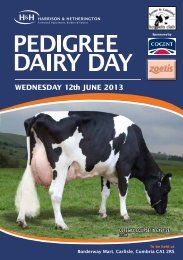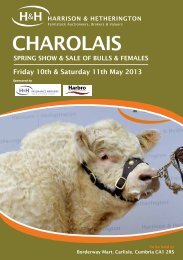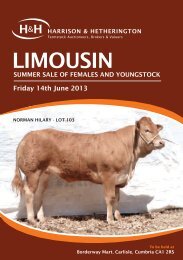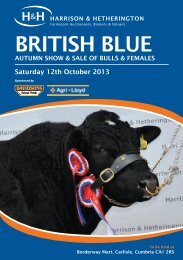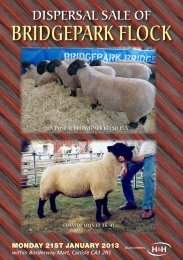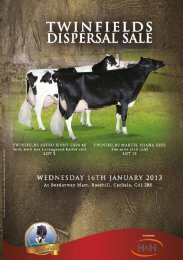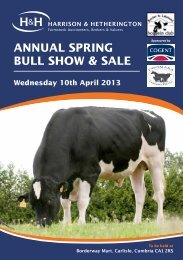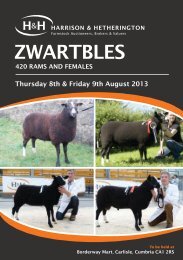liMouSin - Harrison & Hetherington
liMouSin - Harrison & Hetherington
liMouSin - Harrison & Hetherington
You also want an ePaper? Increase the reach of your titles
YUMPU automatically turns print PDFs into web optimized ePapers that Google loves.
12Later growth and carcase traits (i.e. fat and muscle) have relatively high heritabilitiesWhere traits with relatively good heritability are concerned, when something is known of the performance of oneor both parents, then a prediction can be made as to how the offspring will perform and BLUP uses this‘knowledge’ to enhance the accuracy of its EBV calculations.CorrelationsThis term describes the direction and strength of the association between two traits. For example, some traitsare highly positively correlated, such as 200-Day Growth and 400-Day Growth, whilst others are highlynegatively correlated, such as 400-Day Growth and Calving Ease. When something is known of one trait butperhaps not another, a prediction can be made based on what is known about the correlation between them.This again enhances the accuracy of the EBV in question and helps deal with situations where records for a traitare limited or unavailable.3. BREEDING INDEXESIt is often desirable to select animals on the basis of more than one EBV. Indexes focus on specific breedinggoals and combine the appropriate EBVs in to a single figure based on their relative economic value. This iswidely regarded as the most efficient method of selecting on a number of traits at once.Signet currently produces three beef Indexes, as follows:IndexBEEFVALUEContributingEBVsBirth Weight EBV200 Day Weight EBV400 Day Weight EBVMuscle Depth EBVFat Depth EBVIndexCALVINGVALUEContributingEBVsGestation Length EBVCalving Ease EBVIndexMATERNALVALUEContributingEBVs200 Day Milk EBVLongevity EBV*Age First Calving EBV*Calving Interval EBV*Maternal Calving Ease* New EBVs not yet published at breed salesWhen using an Index it is important that your breeding objective is broadly similar to that of the Index inquestion, otherwise you may unwittingly change aspects of your herd that you did not necessarily want to.4. ACCURACYAn Accuracy Value is published next to every EBV and Index. Accuracy Values are expressed as a % andindicates the quantity and quality of records used to produce the EBV or Index.Several things affect the accuracy of an EBV or Index, namely: The amount of information on the trait from the animal itself The amount of information on the trait from relatives of the animal



